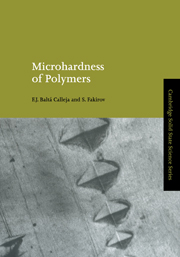Book contents
- Frontmatter
- Contents
- Preface
- Chapter 1 Introduction
- Chapter 2 Microhardness determination in polymeric materials
- Chapter 3 Microhardness of glassy polymers
- Chapter 4 Microhardness of crystalline polymers
- Chapter 5 Microhardness of polymer blends, copolymers and composites
- Chapter 6 Microhardness of polymers under strain
- Chapter 7 Application of microhardness techniques to the characterization of polymer materials
- Author Index
- Subject Index
Chapter 1 - Introduction
Published online by Cambridge University Press: 23 October 2009
- Frontmatter
- Contents
- Preface
- Chapter 1 Introduction
- Chapter 2 Microhardness determination in polymeric materials
- Chapter 3 Microhardness of glassy polymers
- Chapter 4 Microhardness of crystalline polymers
- Chapter 5 Microhardness of polymer blends, copolymers and composites
- Chapter 6 Microhardness of polymers under strain
- Chapter 7 Application of microhardness techniques to the characterization of polymer materials
- Author Index
- Subject Index
Summary
Hardness in materials science and engineering
For about a century engineers and metallurgists have been measuring the hardness of metals as a means of assessing their general mechanical properties. How can one define the hardness of a material? An interesting remark in this respect was made by O'Neil (1967) in his introductory essay on the hardness of metals and alloys. He wisely pointed out that hardness, ‘like the storminess of the seas, is easily appreciated but not readily measured’.
In general hardness implies resistance to local surface deformation against indentation (Tabor, 1951). If we accept the practical conclusion that a hard body is one that is unyielding to the touch, it is at once evident that steel is harder than rubber. If, however, we think of hardness as the ability of a body to resist permanent deformation, a substance such as rubber would appear to be harder than most metals. This is because the range over which rubber can deform elastically is very much larger than that of metals. Indeed with rubber-like materials the elastic properties play a very important part in the assessment of hardness. With metals, however, the position is different, for although the elastic moduli are large, the range over which metals deform elastically is relatively small. Consequently, when metals are deformed or indented (as when we attempt to estimate their hardness) the deformation is predominantly outside the elastic range and often involves considerable plastic or permanent deformation.
- Type
- Chapter
- Information
- Microhardness of Polymers , pp. 1 - 10Publisher: Cambridge University PressPrint publication year: 2000
- 2
- Cited by



